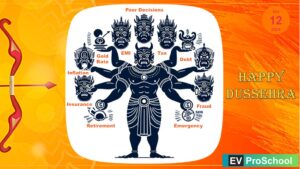Consolidated financial statements are the financial statements of a group presented as those of a single economic entity. A group is made up of a parent and its subsidiaries. The consolidated statement of financial position (SOFP) and the consolidated statement of profit or loss (SOPL) provide an aggregated look at the financial health and performance of the entire group.
Parent Companies and Subsidiaries in EV Industry
In the context of corporate structures, a parent company is an entity that owns or controls one or more subsidiary companies. A subsidiary, on the other hand, is a company that is controlled by another entity, known as the parent company. This control is typically exercised through ownership of a majority of the subsidiary’s voting shares or through other means of control, such as board representation or contractual agreements.
In the EV industry in India, there are several examples of parent companies and their subsidiaries:
Tata Group:
- Parent Company: Tata Sons Limited is the parent company of the Tata Group, a multinational conglomerate with businesses in various sectors, including automotive.
- Subsidiaries: Tata Motors is a subsidiary of Tata Sons and is one of the leading manufacturers of electric vehicles in India. Tata Power is another subsidiary that is involved in providing charging infrastructure for electric vehicles.
Mahindra Group:
- Parent Company: Mahindra & Mahindra Limited is the parent company of the Mahindra Group, a multinational conglomerate with businesses in various sectors, including automotive.
- Subsidiaries: Mahindra Electric Mobility Limited is a subsidiary of Mahindra & Mahindra Limited that focuses on electric vehicles. They produce electric cars, three-wheelers, and electric vehicle components.
Hero Group:
- Parent Company: Hero MotoCorp Limited is the parent company of the Hero Group, a multinational conglomerate with businesses in the automotive sector.
- Subsidiaries: Hero Electric is a subsidiary of Hero MotoCorp that specializes in electric two-wheelers. They offer a range of electric scooters and motorcycles in the Indian market.
Parent Control Over Subsidiary: EV Industry
A parent company typically exercises control over its subsidiaries through various means, such as ownership of voting shares or board representation. This control allows the parent company to influence key decisions of the subsidiary, ranging from strategic business moves to financial activities. In the electric vehicle (EV) industry, examples abound of parent companies exerting control over their subsidiaries, shaping the direction and success of their ventures.
Power over Investee:
- Example: Tata Sons and Tata Motors
- Tata Sons, the parent company of the Tata Group, holds a significant stake in Tata Motors, a leading player in the EV industry. Through its ownership of Tata Motors, Tata Sons has the power to direct the company’s activities, including decisions related to product development, investments in new technologies, and financial strategies. With more than 50% of the voting rights, Tata Sons can influence key decisions that impact Tata Motors’ business direction and performance.
Exposure to Variable Returns:
- Example: Mahindra & Mahindra Limited and Mahindra Electric Mobility Limited
- Mahindra & Mahindra Limited, the parent company of the Mahindra Group, has a subsidiary called Mahindra Electric Mobility Limited, which focuses on electric vehicles. As a parent company, Mahindra & Mahindra Limited is exposed to variable returns from its involvement with Mahindra Electric Mobility Limited. This means that Mahindra & Mahindra Limited’s financial performance is influenced by the success or failure of Mahindra Electric Mobility Limited in the EV market, rather than receiving a fixed return.
Ability to Affect Investor’s Return:
- Example: Hero Group and Hero Electric
- As the parent company, Hero Group can use its power over Hero Electric to affect its own returns. For example, HeroGroup can influence the strategic decisions of Hero Electric, such as product launches or market expansions, to enhance its own financial performance and returns.
In conclusion, the relationship between parent companies and subsidiaries in the EV industry illustrates how control, exposure to variable returns, and the ability to affect investor returns play a crucial role in shaping the strategic direction and success of companies in this dynamic sector.
The Acquisition method
The acquisition method is a standard accounting practice that a company must follow when it acquires another business entity. It is used to account for the purchase of a subsidiary by a parent company, where the parent gains control over the subsidiary. This method requires the parent company to record the assets and liabilities of the subsidiary at their fair values at the acquisition date.
Under the acquisition method, several key steps are involved:
- Identifying the Acquirer: The acquiring company, or parent, is identified as the entity that obtains control over the acquired business, or subsidiary.
- Determining the Acquisition Date: This is the date on which the acquirer obtains control over the acquired business. The assets, liabilities, and equity interests of the acquired business are measured at their fair values as of this date.
- Recognizing and Measuring Identifiable Assets and Liabilities: The acquirer recognizes and measures the identifiable assets acquired, liabilities assumed, and any non-controlling interest in the acquired business at their fair values at the acquisition date.
- Recognizing and Measuring Goodwill or Gain from Bargain Purchase: Any excess of the consideration transferred, the amount of any non-controlling interest in the acquiree, and the fair value of the acquirer’s previously held equity interest in the acquiree over the fair value of the identifiable net assets acquired is recognized as goodwill. If the fair value of the net assets acquired exceeds the consideration transferred, the acquirer recognizes the resulting gain in profit or loss, unless it is attributable to non-controlling interests.
- Recognizing and Measuring Deferred Tax Assets and Liabilities: The acquirer recognizes any deferred tax assets or liabilities arising from the acquisition, which are measured at the tax rates that are expected to apply to the taxable profits in the periods in which the deferred tax asset is realized or the deferred tax liability is settled.
- Disclosure: The acquirer discloses information that enables users of its financial statements to evaluate the nature and financial effects of the business combination.
Overall, the acquisition method provides a systematic way to account for business combinations, ensuring that the financial statements of the parent company accurately reflect the assets, liabilities, and equity interests acquired, as well as any goodwill or gain from bargain purchase arising from the acquisition.
Why Consolidate?
Consolidation is vital for providing a transparent and fair view of a parent company’s operations. It ensures that end users of financial reports are not misled by the financial activities among subsidiaries. It eliminates internal transactions and balances, thus presenting a clear picture of the group’s external financial dealings.

Consolidated Financial Statements:
When a company acquires a controlling interest in another company, it is considered a single economic event. This event is accounted for using the acquisition method, where the assets, liabilities, and equity of the acquired company are recorded at their fair values at the acquisition date. The consolidated financial statements, including the CSOPL, CSOFP, CSOCF, CSOCIE, and Notes to Accounts, are prepared to present the financial results and financial position of the combined entity after the acquisition.
These statements consolidate the financial information of the acquiring company and the acquired company, treating them as a single economic entity. This approach provides stakeholders with a comprehensive view of the group’s financial performance and financial position, including the effects of the acquisition. The consolidated financial statements include:
- Consolidated Statement of Profit and Loss (CSOPL): This statement combines the revenues, expenses, gains, and losses of the parent company and its subsidiaries. It shows the overall financial performance of the group.
- Consolidated Statement of Financial Position (CSOFP): This statement combines the assets, liabilities, and equity of the parent company and its subsidiaries. It provides a snapshot of the group’s financial position at a specific point in time.
- Consolidated Statement of Cash Flows (CSOCF): This statement shows the cash inflows and outflows of the parent company and its subsidiaries. It helps to assess the group’s ability to generate cash and its cash management practices.
- Consolidated Statement of Changes in Equity (CSOCIE): This statement summarizes the changes in the equity of the parent company and its subsidiaries. It shows how the group’s equity has changed over time.
- Consolidated Statement of Comprehensive Income (CSOCI): This statement shows the comprehensive income of the group, which includes both net income and other comprehensive income items.
- Notes to Accounts: These are additional disclosures that provide further details about the group’s financial performance, financial position, and cash flows. They include information about accounting policies, significant events, and transactions.
Preparing consolidated financial statements is important because it provides a more complete picture of the group’s financial performance and financial position. It reflects the economic reality of the group as a single economic entity, rather than as a collection of individual companies. This information is useful for investors, creditors, and other stakeholders in assessing the group’s financial health and performance.

Rules in the Preparation of Consolidated Reports
- Combining Assets, Liabilities, Incomes, and Expenses:
- Example: Let’s say Company A acquires 80% of the shares of Company B for $1,000,000. Company B has assets worth $800,000 and liabilities of $300,000. After the acquisition, Company A consolidates its financial statements with those of Company B. The combined financial statement would show total assets of $1,800,000 ($800,000 + $1,000,000), and total liabilities of $300,000, reflecting the consolidation of the two entities.
2. Recognizing Goodwill:
- Example: Using the same scenario as above, if the fair value of the identifiable net assets acquired from Company B is $700,000, then the excess of the consideration transferred ($1,000,000) over the fair value of the net assets acquired ($700,000) is recognized as goodwill. Therefore, goodwill arising from the acquisition is $300,000.
3. Treating Share Capital:
- Example: If Company A’s share capital is $2,000,000 and it acquires 80% of Company B, then after the acquisition, the share capital of the group would be $2,000,000, as the share capital of the parent is considered to be the share capital of the group.
4. Recognizing Non-Controlling Interest (NCI):
- Example: If Company A acquires 80% of Company B, the remaining 20% is considered non-controlling interest. If Company B has a net income of $100,000, 80% ($80,000) would be attributed to Company A and 20% ($20,000) would be attributed to the NCI.
5. Attributing Profit and Comprehensive Income:
- Example: Continuing with the previous example, if the consolidated net income of the group after the acquisition is $500,000, $400,000 (80%) would be attributed to Company A’s owners and $100,000 (20%) would be attributed to the NCI. Similarly, comprehensive income would be attributed based on the ownership percentages.
Here’s the explanation in the requested format:
| Item | Company A | Company B | Consolidated | Explanation |
|---|---|---|---|---|
| Non-Current Assets | – | $800,000 | $800,000 | Company B’s non-current assets are included in the consolidated financial statement, reflecting the assets acquired through the acquisition. |
| Goodwill | $300,000 | – | $300,000 | Goodwill of $300,000 is recognized, representing the excess of the consideration paid by Company A over the fair value of the net assets acquired from Company B. |
| Investment in Company B by Company A | $1,000,000 | – | – | The investment made by Company A to acquire 80% of Company B’s shares. This is not recognized in the consolidated financial statement as it represents the initial transaction and does not affect the group’s financial position. |
| Current Assets | – | – | – | Current assets are not impacted by the acquisition and are not consolidated. |
| Total | – | – | $1,100,000 | The total value of assets in the consolidated financial statement, including both Company A and Company B’s assets. |
| Equity | – | – | – | Equity reflects the ownership interest in the consolidated entity. |
| Share Capital | – | – | – | The share capital of the consolidated entity is not affected by the acquisition. |
| Retained Earnings | – | – | – | Retained earnings represent the accumulated profits of the consolidated entity. |
| Current Liabilities | – | $300,000 | $300,000 | Company B’s current liabilities are included in the consolidated financial statement, reflecting the liabilities assumed through the acquisition. |
| Total | – | – | $1,100,000 | The total value of liabilities and equity in the consolidated financial statement, including both Company A and Company B’s liabilities and equity. |
These rules of acquisition accounting ensure that the financial statements of the parent and its subsidiaries are consolidated in a manner that reflects the economic reality of the group as a single entity, providing a clear and accurate representation of its financial position and performance.
Consolidated Statement of Financial Position
The Consolidated SOFP brings together all assets and liabilities of the parent company and its subsidiaries. It reports assets, liabilities, and equity interests while excluding inter-company transactions and balances. Here’s a simplified structure:
- Non-current assets (Total of the group, minus inter-company balances)
- Current assets
- Total assets
- Equity attributable to owners of the parent
- Non-controlling interest
- Non-current liabilities
- Current liabilities
- Total equity and liabilities
Consolidated Statement of Profit or Loss
The Consolidated SOPL combines the individual profit or loss statements into one statement, showing the group’s net result.
- Revenue (minus intra-group sales)
- Cost of sales
- Gross profit
- Administrative expenses
- Other operating income/expenses
- Profit before tax
- Tax expense
- Profit for the year from continuing operations
- Attributable to:
- Owners of the parent
- Non-controlling interests
Example for an EV Conglomerate:
Let’s consider a simplified example of an electric vehicle conglomerate, ElectraMotors Group, that has a parent company and two wholly-owned subsidiaries.
Consolidated SOFP
(All figures are in INR Crores)
- Non-current assets: 12,000
- Current assets: 5,000
- Total assets: 17,000
- Equity attributable to owners of the parent: 10,000
- Non-controlling interest: 0
- Non-current liabilities: 4,000
- Current liabilities: 3,000
- Total equity and liabilities: 17,000
Consolidated SOPL
(All figures are in INR Crores)
- Revenue: 20,000
- Cost of sales: (12,000)
- Gross profit: 8,000
- Administrative expenses: (2,000)
- Other operating income: 500
- Profit before tax: 6,500
- Tax expense: (2,000)
- Profit for the year from continuing operations: 4,500
- Attributable to owners of the parent: 4,500
- Non-controlling interests: 0
Preparing consolidated financial statements is an intricate process that requires careful attention to the details of inter-company relationships and the individual financial activities of each entity within the group. It is an essential practice for upholding the principles of transparency and accountability in financial reporting.
Note: For a full tutorial, including detailed tables and line items, it would be more appropriate to refer to specialized accounting resources or financial textbooks that offer comprehensive examples and reporting formats.



